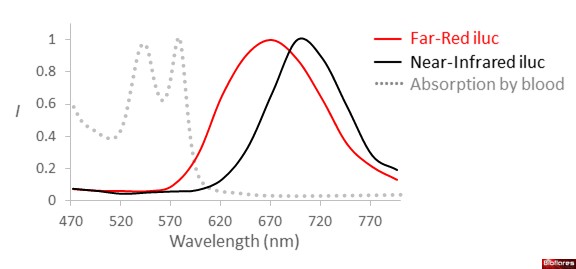Dual Parameter Near-Infrared Bioluminescence
Bioluminescence—the natural “living light” produced by organisms such as fireflies—is a powerful tool in biomedical research. Firefly bioluminescence has long been used as a non-invasive marker to track cells, monitor gene expression, and visualize biological and disease processes in vivo. In recent years, firefly bioluminescence has been re-engineered to emit at far-red to near-infrared (NIR) wavelengths, enabling deeper tissue penetration and clearer imaging in mammals. This innovation has greatly expanded its applications in biomedical imaging.
Infraluciferin is a unique, color-shifting analogue of firefly luciferin, the natural substrate responsible for light emission in fireflies. Unlike native luciferin, infraluciferin produces far-red to NIR bioluminescence, which penetrates mammalian tissue more efficiently. Importantly, the emission wavelength depends on the luciferase enzyme variant it reacts with, allowing the same substrate to generate different “colors” of light. This enables true dual-parameter bioluminescence imaging (BLI)—for example, simultaneously tracking two cell populations or monitoring two different gene expression events within a living organism.
The methyl ester of infraluciferin, supplied by Bioflares, is the preferred form for biological studies. This ester is cell-permeable and stable, and once inside cells it is converted by endogenous esterases into the active infraluciferin substrate. In the presence of firefly luciferase (or engineered variants), ATP, and oxygen, this substrate produces far-red or NIR light, depending on the luciferase protein sequence. Imaging with infraluciferin is non-invasive, compatible with longitudinal studies, and suitable for whole-animal work in models such as mice.
To maximize performance, Bioflares also provides access to engineered infraluciferase (iLuc) enzyme variants, which deliver enhanced brightness and are specifically optimized for dual-parameter in vivo BLI. (See the infraluciferase section of our website for further details and literature references.)
Bioluminescence reaction of D-infraluciferin methyl ester in cells or in vivo:

Schematic illustration of the spectral advantages of using infraluciferin for dual parameter in vivo bioluminescence imaging using infraluciferase (iluc) enzymes:

Dual parameter NIR bioluminescence spectra (red and black lines) at wavelengths beyond blood absorption (oxygenated blood absorption spectrum shown by dotted line)
For selected literature references on infraluciferin click here